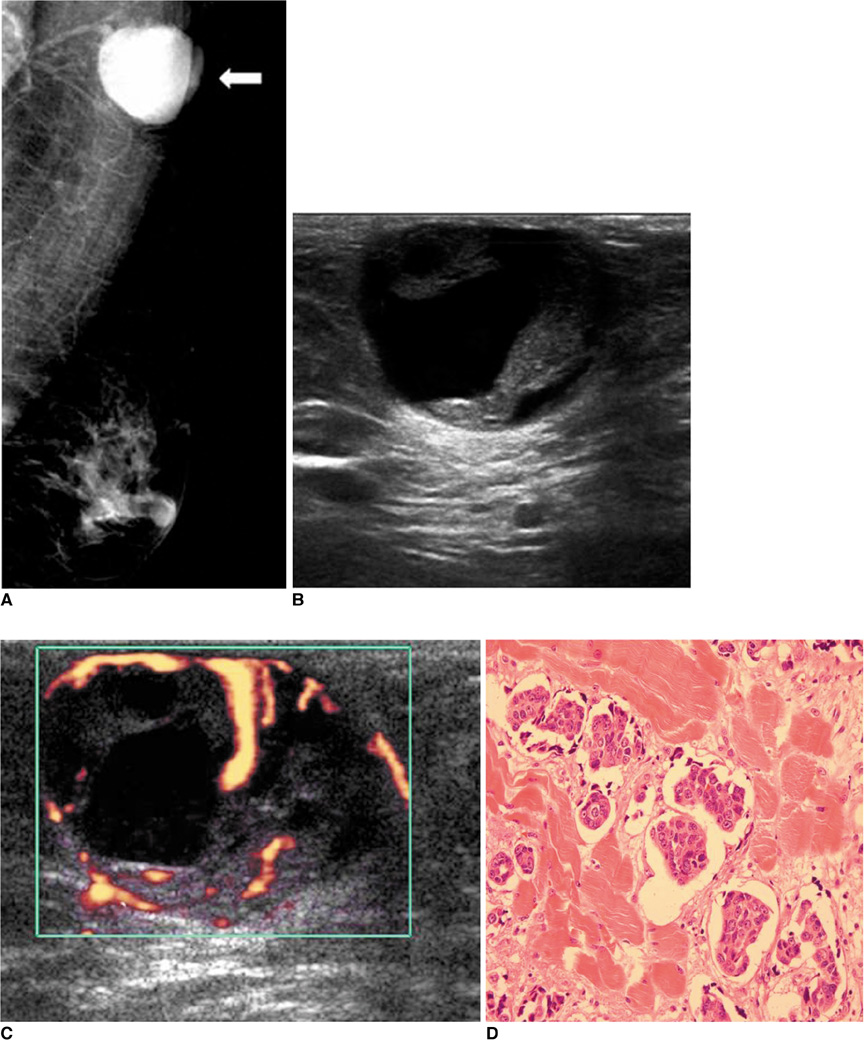Korean J Radiol.
2010 Aug;11(4):490-492. 10.3348/kjr.2010.11.4.490.
Clear Cell Hidradenoma of the Axilla: a Case Report with Literature Review
- Affiliations
-
- 1Department of Radiology, Yonsei University College of Medicine, Seoul 135-720, Korea. ejsonrd@yuhs.ac
- 2Department of Surgery, Yonsei University College of Medicine, Seoul 135-720, Korea.
- KMID: 984906
- DOI: http://doi.org/10.3348/kjr.2010.11.4.490
Abstract
- Clear cell hidradenoma is an uncommon benign skin appendageal tumor that typically involves the dermal layer of the head, face, and extremities. The breast is a rare site for this lesion, with only two documented cases, which were determined based on mammogram and sonogram findings. We present a case of clear cell hidradenoma of the axillary tail with radiological findings and a literature review.
Keyword
MeSH Terms
Figure
Cited by 1 articles
-
Clear Cell Hidradenoma and Hidradenocarcinoma Arising from Benign Hidradenoma: Imaging Findings of Ultrasonography and CT
Jiyeon Ha, Hye Won Chung, Joon Seon Song
J Korean Soc Radiol. 2019;80(4):768-772. doi: 10.3348/jksr.2019.80.4.768.
Reference
-
1. Jin W, Kim GY, Lew BL, Yang DM, Kim HC, Ryu JK, et al. Sonographic findings of an eccrine spiradenoma: case report and literature review. J Ultrasound Med. 2008. 27:813–818.2. Mullaney PJ, Becker E, Graham B, Ghazarian D, Riddell RH, Salonen DC. Benign hidradenoma: magnetic resonance and ultrasound features of two cases. Skeletal Radiol. 2007. 36:1185–1190.3. Ghai S, Bukhanov K. Eccrine acrospiroma of breast: mammographic and ultrasound findings. Clin Radiol. 2004. 59:1142–1144.4. Ohi Y, Umekita Y, Rai Y, Kukita T, Sagara Y, Sagara Y, et al. Clear cell hidradenoma of the breast: a case report with review of the literature. Breast Cancer. 2007. 14:307–311.5. Shaikh-Naidu N, Breitbart A. Eccrine spiradenoma of the upper extremity: case report and an algorithm for management. Eur J Plast Surg. 2003. 26:160–163.6. Revis P, Chyu J, Medenica M. Multiple eccrine spiradenoma: case report and review. J Cutan Pathol. 1988. 15:226–229.7. El Demellawy D, Daya D, Alowami S. Clear cell hidradenoma: an unusual vulvar tumor. Int J Gynecol Pathol. 2008. 27:457–460.8. Hernández-Pérez E, Cestoni-Parducci R. Nodular hidradenoma and hidradenocarcinoma. A 10-year review. J Am Acad Dermatol. 1985. 12:15–20.9. Han YD, Huan Y, Deng JL, Zhang YG, Zhang CH. MRI appearance of multiple eccrine spiradenoma. Br J Radiol. 2007. 80:E27–E29.


